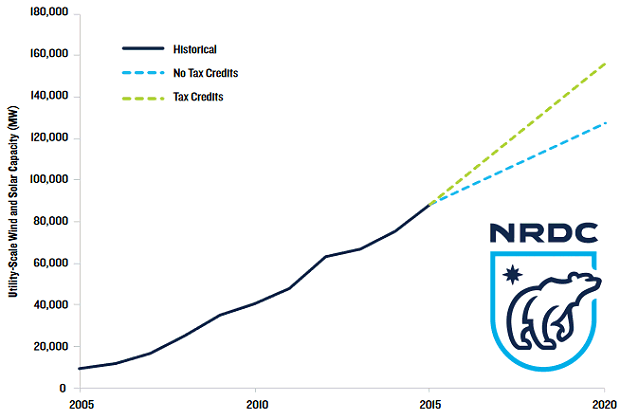U.S. federal wind and solar investment tax credits will create more than 220,000 jobs and add nearly $23 billion to the nation’s economy this year states a new report.
The investment tax credit (ITC) is a 30 percent credit for wind, solar power and energy storage systems. The program has been a significant contributor to the rollout of renewables in the USA.
The ITC’s current level of support was due to expire by the end of next year, but was extended in 2015. Under current arrangements, the tax credits for onshore wind are gradually phased out and will expire at the end of 2019. Credits will also be gradually phased out until they expire after 2021 for residential solar power installations.
Credits for commercial and utility scale solar energy will be gradually reduced to 10 percent after 2021 and then will remain at that level.
Kevin Steinberger, Policy Analyst, Climate & Clean Air program at the NRDC says recent action to begin rolling back President Barack Obama’s Clean Power Plan represents a major threat to the ITC.
NRDC has just released a new analysis (PDF) authored by Mr. Steinberger detailing the many benefits of maintaining the initiative.

Assuming they continue, the tax credits will have driven nearly 29,000 MW of additional wind and solar capacity between 2015 and 2020. This is enough to power nearly eight million homes and 23 percent more capacity than in a situation without the tax credits.
According to the analysis, average wholesale power prices will be 2.2 percent lower and natural gas prices 1.5 percent lower in 2020 compared with a “No Tax Credits” scenario.
With regard to employment, there will be an average annual employment gain of over 80,000 jobs between 2016 and 2025 above a scenario without tax credits.
Maintaining the initiative will also see significant environmental benefits; including a reduction of carbon emissions by 45 million tons (2.2 percent) in 2020 and slashing nitrogen oxide and sulfur dioxide pollution by 40,000 tons (3.2 percent) and 22,000 tons (1.6 percent) respectively in 2020.
“This analysis makes a clear and compelling case to build on this progress to achieve even stronger, more persistent job gains and economic growth,” says Mr. Steinberger.
” The time is ripe to further accelerate our urgently needed transition to a low carbon economy.”







































